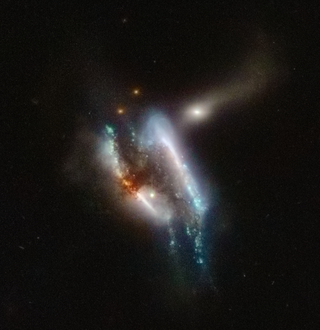Top Qs
Timeline
Chat
Perspective
IC 2431
Interacting galaxies in the constellation Cancer From Wikipedia, the free encyclopedia
Remove ads
IC 2431 are a group of interacting galaxies in the constellation of Cancer.[1][2] They are located 684 million light-years away from the Solar System[3] and were discovered on February 24, 1896, by Stephane Javelle.[4]
Remove ads
Characteristics
Summarize
Perspective
There are at least three galaxies involved in the gravitational interaction. They are IC 2431 NED01 (known as PGC 200245),[5] IC 2431 NED02 (known as NSA 135647)[6] and IC 2431 NED03 (known as PGC 200246).[7] Additionally, a fourth galaxy (PGC 200247)[8] might also be involved in the interaction. As they draw closer to each other, the forces are causing them to tear each other apart.[9] This is common in the universe and all large galaxies, including the Milky Way own their size to violent mergers.[9]

The galaxies are undergoing tumultuous mixture of star formation and tidal distortions which are caused by the interaction.[10] In the center, a thick cloud of dust is seen obscuring, which light from a background galaxy is piercing its outer extremities.[10] Also, they display a thermally-dominated X-ray emission which is much more in excess of expectations based on its own star formation rate.[11]
IC 2431 falls under the category of Markarian Galaxies as Mrk 1224,[3] in which its core shines bright in ultraviolet rays. It is possible that carbon monoxide might be present in the regions of the interacting galaxies, which can be determined by the fraction of interstellar gas and total mass in form of molecules.[12] Not to mention, IC 2431 possibly contains an active nucleus which produces ionized gas outflows.[13][14]
Remove ads
References
Wikiwand - on
Seamless Wikipedia browsing. On steroids.
Remove ads

